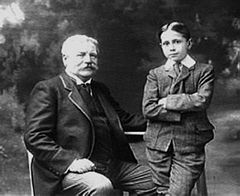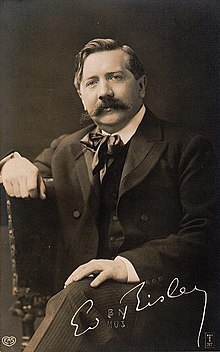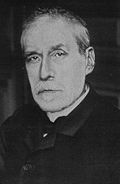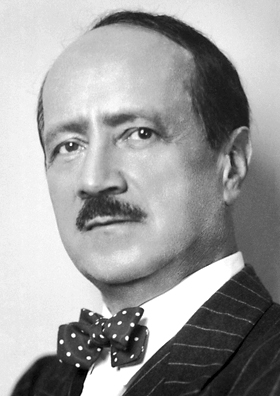 |
| Boutroux |
p 448 | Émile Boutroux (1845-1921) was an eminent 19th century French philosopher of science & religion and an historian of philosophy. He firmly opposed materialism in science. He ... defended the idea that religion & science are compatible... His work is overshadowed... by that of his student, the more celebrated Henri Bergson. He was elected to the Academy of Moral & Political Sciences in 1898 & to the Académie française in 1912. (Wiki)
 |
| Académie française |
p 448-9 | Henri Houssaye; Olivier Lefèvre d'Ormesson; Édouard René de Laboulaye: Honoré Le Peletier, comte d'Aunay; M. de Bussière; M. Albaret; M. de Cholet; M. dela Pommeraye
 p 449 | Paul Porel (Paul Désire Parfouru, 1843-1917), actor & theater director, who ran the Odéon on the Left Bank, from 1884 to 1892, hence "Odéonia." He was married to the comedienne Réjane (one of the models for Berma), who, with their son Jacques Porel were friends with Proust.
p 449 | Paul Porel (Paul Désire Parfouru, 1843-1917), actor & theater director, who ran the Odéon on the Left Bank, from 1884 to 1892, hence "Odéonia." He was married to the comedienne Réjane (one of the models for Berma), who, with their son Jacques Porel were friends with Proust. p 449 | The Théâtre de l'Odéon is one of France's six national theatres. It is located at 2 rue Corneille in the 6th arrondissement of Paris on the left bank of the Seine, next to the Luxembourg Garden. It was originally built between 1779 and 1782, in the garden of the former Hôtel de Condé, to a Neoclassical design by Charles De Wailly and Marie-Joseph Peyre. The Odéon was originally intended to house the Comédie Française, which, however, preferred to stay at the Théâtre-Français in the Palais Royal. The new theatre was inaugurated by Marie-Antoinette on April 9, 1782.
p 450 | Even though Moncrieff uses "-ast" here, the French has "-arder", which Sturrock suggests could possibly stand for pétarder, meaning "to blow one's top" -- and possibly several other slangy meanings. I think Moncrieff used his translator's licence to indicate that the two men were gossiping about Charlus being gay (i.e., "pederast"). Remember Marcel has already indicated that the people in one's social circle wouldn't mention or notice it, but outsiders would do both.
p 452 | La Chercheuse d'esprit, a comic opera with words by Charles-Simon Favart (1710-92) and music by Jean-Claude Trial (1732-71), first presented in 1741.
p 453 | The Sarmatians were a large confederation of Iranian people during classical antiquity, flourishing from about the 5th century BC to the 4th century AD. They spoke Scythian, an Indo-European language from the Eastern Iranian family.
p 454 | ... the Rohans...: The House of Rohan is a French noble family of viscounts, later dukes and princes, coming from the locality of Rohan in Brittany.
| architrave |
| Odéon |
p 455 | Mme Jeanne Samary: 19th century actress and model (Renoir's lover for a while).
p 455 | Le Capitaine Fracasse by Théophile Gautier: This book was promised to the public in 1836 but finally published in 1863. It is centered on a soldier named Fracasse whose adventures portray bouts of chivalry, courage and a sense of adventure. Gautier places the story in his favourite historical era, that of Louis XIII. It is best described as a typical cloak-and-dagger fairy tale where everyone lives happily ever after.







.jpg/200px-Moli%C3%A8re_-_Nicolas_Mignard_(1658).jpg)







